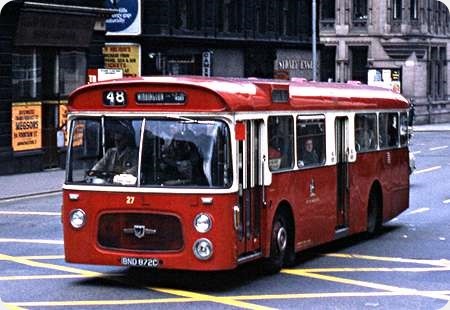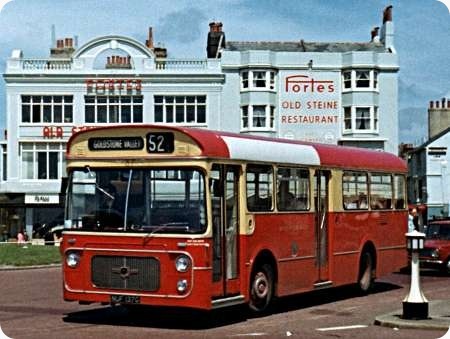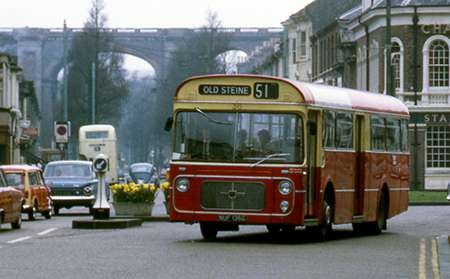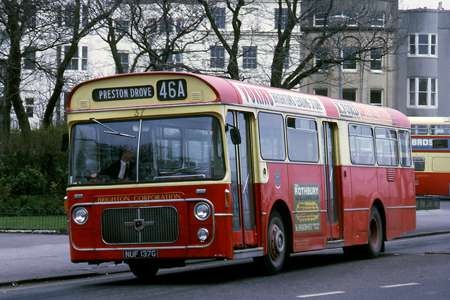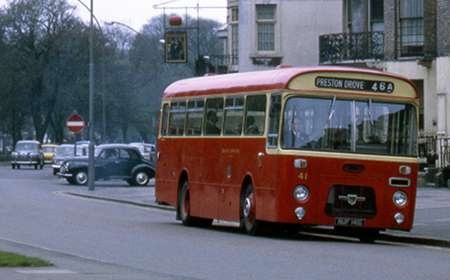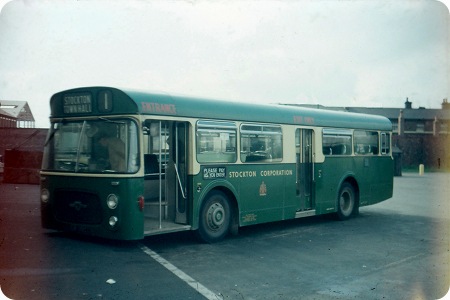Manchester Corporation - Panther Cub - BND 872C - 72
Manchester Corporation
1965
Leyland Panther Cub PSRC1/1
Park Royal B43D
Delivered in April 1965 and photographed in June 1970 following the formation of Selnec is Manchester Corporation Panther Cub No 72, BND 872C. The Panther Cub was a shortened version of the Panther, the length being reduced from 36ft. to 33ft. 6ins. on an 18ft. 6ins wheelbase. With the 6.5 litre Leyland O400H engine instead of the Panther’s 9.8 litre O600H, the Panther Cub proved to be somewhat underpowered. The limited appeal of the model resulted in its being offered only from 1964 to 1968 during which 94 examples were built, though the same basic chassis with more powerful AEC engines was more successful as the AEC Swift. Manchester took eight Panther Cubs, BND 863C- 880C, Nos. 63 to 80, with Park Royal B43D bodywork, though the seating capacity was later altered on No. 71 to B36D and on No. 74 to B42D. The Corporation tried to improve the engine output on some of these buses by experimenting with turbocharging, not entirely successfully. The picture above is of additional interest in that the fleet number of BND 872C is displayed as 27 rather than 72. Was this just an inadvertent “numerical spoonerism” by the body shop?
Photograph and Copy contributed by Roger Cox
09/02/20 - 08:31
The legal lettering on a Southampton Atlantean mentioned, for some odd reason, PROTSWOOD Road rather than the correct PORTSWOOD. I saw in Stubbington on one occasion a road marking for GOPSROT, and there is a hotel in Southampton which ‘failed’ some years ago. The rot seems to have set in after the opening of a brasserie, spelled incorrectly after one has to assume the sign writer was distracted by the presence of a lap-dancing club opposite. Who knows what distractions the fellow applying 27 had?
Pete Davies
09/02/20 - 10:22
The fleet number is correct - it had been renumbered not long before when Manchester renumbered their single-deckers from 46 upwards as 1 upwards (so fleet numbers were reduced by 45). The whole batch of Panther Cubs totalled twenty with the original pair new as 61/62 (ANF 161/2B).
David Beilby
10/02/20 - 06:47
CPPTD made a success of our Panther Cubs, mainly because the city is mostly dead flat. One survives.
Dave French
10/02/20 - 06:48
Thanks for the corrections, David. I overlooked the original two. I did not know that these buses had been renumbered - Peter Gould’s LTHL listings do not record this. Apologies also for the typo in my copy. Eight should read eighteen.
Roger Cox
10/02/20 - 06:50
I didn’t know about that renumbering, and evidently I’m not alone, as Peter Gould’s fleet history in the Transport History Library says that 61-80, 81-99 and 101-110 passed to SELNEC retaining the same fleet numbers. I wonder, did the missing Panther 100 (destroyed by fire at MCW before delivery) result in a missing 55, or were 101-110 reduced by 46 instead of 45?
Peter Williamson
10/02/20 - 11:12
I suppose Portsmouth (CPPTD) could be described as making more of a success of the Panther Cub, but they were still rather short-lived compared with more traditional vehicles. Typically, the PD2s and PDR1 Atlanteans worked for around 16 years, those converted to open-top even longer. But of the 26 Panther Cubs, nine went in 1977, at just ten years old. Four more went in 1979/80. The remaining 13 were withdrawn in 1981, which may have been life-expired withdrawals, but was also influenced by the results of the then-recent MAP project. The result of that saw a "rationalisation" of services, and saw all 14 of the five-year old Leyland Nationals sold as well! The Panther Cubs did look smart when new in their traditional CPPTD livery, but I did not like the eventual transformation to an almost all-white scheme with just a red line. I wonder whether drivers, mechanics, etc saw them as a "success"?
Mr Anon One
10/02/20 - 11:13
It was SELNEC which renumbered the ex Manchester single deckers.
Mr Anon Two
11/02/20 - 06:53
To add to the comments from Mr Anon Two, according to the P.S.V. Circle SELNEC
Fleet History (PC7), the vehicles transferred to SELNEC under their old numbers on 1st November
1969, and the fleet renumbering was introduced in March 1970.
Peter W asks about the Panther
Cubs and the Panthers. 61-99 became 16-54, and 101-110 became 55-64.
John Kaye
11/02/20 - 06:55
SELNEC 55 was GND 101E, so there was no gap in the new numbers for the missing GND 100E.
Dave Farrier
11/02/20 - 16:26
Thanks everyone for clarification. I hadn’t noticed the date of the photo, and I was fooled by the apparent survival of the "City of Manchester" fleet name, though I must say whatever is above it doesn’t look much like the city coat of arms.
Peter Williamson
12/02/20 - 16:46
Did the registration number GND 100E signify the bus was fitted with a Ford side valve engine? If so, it is not surprising that it was missing, although not in the accepted sense of the word. Try changing the plugs!
Mr Anon Three
13/02/20 - 06:06
72/4/6/8/80 were allocated to Queens Road Depot from new. I used to travel to
school on them sometimes on service no 142. There was one regular driver who always started in third
gear, another started in second then slammed it into fourth without a pause. I always thought they
were lively performers.
I believe 61-70 had the turbocharged engine. Some if not all of these
had machines to cancel prepaid tickets which were bought in books of ten. These ten also had lever
controls for the exit door, while 71-80 had the exit door controlled by an extra position on the
gear lever, as later became standard on the Mancunians. All had the front door controlled by a foot
control.
Don McKeown
15/02/20 - 06:31
It was 71-80 that had the turbochargers, but they were troublesome and usually disconnected. I too thought the Panther Cubs were lively performers, as long as the revs were kept up. I’m quite surprised at the widespread view that they were underpowered.
Peter Williamson
Quick links to the - Comments Page - Contact Page - Home Page
